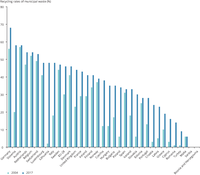
Recycling rates of municipal waste in 2004 and 2017

Cumulative number of new non-indigenous species (NIS) aggregated per 6 years in all European Seas, 1949-2017, per functional group (Invertebrates, vertebrates and primary producers, (EU + non EU)

Mean annual productivity of the White-tailed eagle in the Baltic Proper, Swedish coastal area

The chart shows the periodical change of land cover classes, expressed in km2 and calculated as a yearly value.

The chart shows the area of land take and recultivation for the last Corine Land Cover observation period 2012-2018 for each EEA39 country. Both land take and recultivation are expressed in m2/km2 of the country area for the sake of comparability.

The number of assessements is indicated in parentheses. The total number of assessments is 804.

Concentrations of BOD5, orthophosphate, and nitrates in rivers, and nitrates in groundwater.

Common bird index shows the population trends of farmland, forest and all common bird species

The chart shows the annual classified Eutrophication status in each of 9 basins of the Baltic Sea over the period from 1901 to 2012. The status is assigned one of five classes "High", "Good", "Moderate", "Poor" or "Bad", depending on the Eutrophcation Ratio calculated by the HEAT tool. See more details in Andersen et al. (2015) Biol. Rev. 1 doi: 10.1111/brv.12221

The left map uses a colour gradient to show the long-term unemployment rate per NUTS2 region, classified in quantiles, against the highest number of cooling degree days as hatched areas (only the top 20 % of regions with the highest number of CDDS are shown). The right map uses a colour gradient to show the percentage of the elderly per NUTS2 region, classified in quantiles, against the highest number of cooling degree days represented as hatched areas (only the top 20 % of CDDs are shown).

The study takes a conservative approach, as it calculates the European share based on the
lower end values of the global zone of uncertainty de ned by Ste en et al. (2015). For example,
the global zone of uncertainty for Freshwater is de ned as 4000-6000 km3 in Ste en et al. (2015).
This study uses 4000 km3 as the basis for calculating the European share. In some cases (indicated
in brackets) slightly di erent control variables have been used than in Ste en et al. (2015).The yellow zone of uncertainty represents the average range across six principles to allocate a European share of the global safe operating space (equality, needs, rights to development, sovereignity, capability).More information in the forthcoming EEA report

Correlation between Ecological Footprint and Human Development Index (HDI). HDI values above 0.8 are defined as "Living well", Ecological footprint values below 1.7 are defined as "Living within environmental limits".The value of 1.7 refers to the average biocapacity per person globally in 2014 (see also http://data.footprintnetwork.org/#/exploreData. The HDI value of 0.8 refers to 'very high human development', according to UNDP (see http://hdr.undp.org/en/content/energising-human-development)

The graph distinguishes 4 material groups (in tonnes): biomass, non-metallic minerales, fossil fuels, metal ores
Document Actions
Share with others